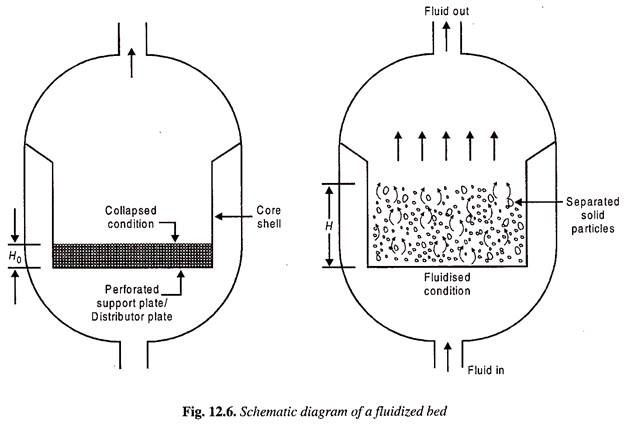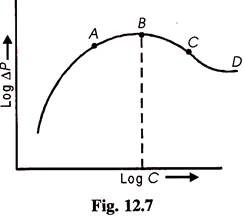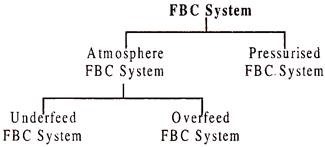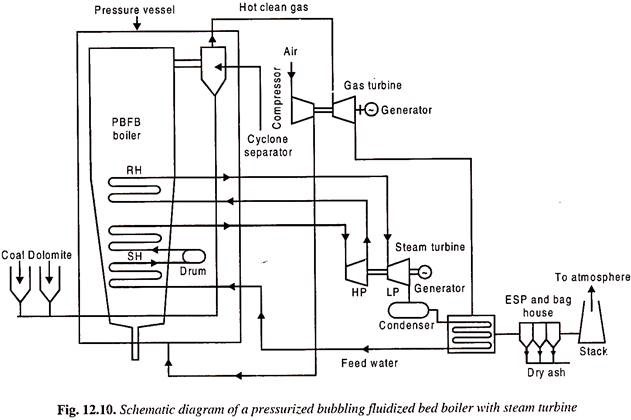In this article we will discuss about:- 1. Introduction to FBCs 2. Principle of Working of Fluidised Bed Combustion 3. Types 4. Pressurized Bubbling Fluidized Bed Boiler (PBFB) 5. Advantages.
Contents:
- Introduction to FBCs
- Principle of Working of Fluidised Bed Combustion
- Types of FBC Systems
- Pressurized Bubbling Fluidized Bed Boiler (PBFB)
- Advantages of FBC System
1. Introduction to FBC System:
(a) Oil and gas prices increased in recent decades.
ADVERTISEMENTS:
(b) Coal is available in large quantities.
(c) Pulverized coal burning system is costly and the combustion takes place at 1400-1600°C at which NOx is produced.
(d) At high temperature, ash forms a slag on super heater tubes and causes fouling, corrosion and reduces heat transfer rates.
To overcome these difficulties a new coal combustion system is developed and is called as Fluidized Bed Combustion System, (FBCS).
ADVERTISEMENTS:
In this system any type of coal can be burnt efficiently in the temperature range of 900-1000°C. At these temperatures production of pollutant like NOx is less, and slag formation is almost nil.
It is to be noted that FBCS is introduced in 1950s and aims at removing sulphur from coal during combustion process itself and reducing to formation of NOx.
2. Principle of Working of Fluidised Bed Combustion
:
Figure 12.6 shows the simple fluidised bed combustion which has a distributor or perforated support plate on which finely divided particles of fuel (6 mm-20 mm) are provided and the particles are in collapsed state. Air is passed in the upwards direction with low velocities. The pressure drop across the combustion chamber can be measured with the help of a manometer.
The velocity of air is gradually increased and the logarithmic plot of ΔP and velocities C is shown in Fig. 12.7.
Up to A — The bed is stable.
Between A and B – The bed is unstable particles adjust their position to present as little resistance to flow as possible.
ADVERTISEMENTS:
At B – The particles are just in contact with each other.
Beyond B – Beyond this point – on further increase in velocity, the particles start moving freely in the bed with frequent collisions with each other. Point B is called the point of fluidisations and the corresponding velocity is called the minimum fluidisation velocity.
Beyond point B, on further increase in velocity, the resistance to flow decreases as freely suspended in gas stream. In this state, the bed continues to expand and it becomes turbulent; also there is rapid mixing of particles. Under these conditions the mixture of bed and gas behaves like a fluid and the burning of fuel in such a state is called fluidized bed combustion.
It consists of a shell with a distributor plate at its bottom with holes in it. The shell carries the boiler evaporator tubes which remain immersed in the fluidized bed as shown. Coal of 6 to 20 mm size with dolemite or lime stone are fed on the distributor plate. Air is supplied from the bottom at a velocity more than the minimum velocity of fluidisation.
ADVERTISEMENTS:
The heat energy released due to combustion is rapidly transferred at high rates to water in the evaporator tubes and the generated steam is taken out. The sulphur content of the coal is converted into SO2 on burning and SO2 is mostly absorbed by dolemite. Hence the flue gases leaving the bed are almost free from SO2 gas. The molten ash formed is taken out from the top as shown. Such a system reduces the size of the boiler considerably due to high rates of heat transfer.
3. Types of FBC Systems
:
The FBC systems are classified as:
(1) Atmospheric FBC System:
Atmospheric fluidized bed combustion systems are presently in fully developed state and these are being used in many power plants. In these systems, the pressures inside the combustion chamber are kept atmospheric. These are for further classified as underfeed and overfeed systems based on whether the loading of the fuel and supply of air is from the bottom of the bed or on the top of the bed respectively.
Underfeed atmospheric FBC systems are compact in design, but, they have high operational costs. While the overfeed atmospheric FBC systems are simple in operation with less operational cost but these give lower heat transfer rates per m2 of area of the bed.
(2) Pressurised FBC System:
Pressurised FBC system is the latest development used for generation of power in which air is supplied under pressure of 10 bar approximately. With the help of an air compressor driven by a gas turbine. The supply of air under pressure results into better rates of heat transfer compared to atmospheric FBC system.
The sketch is self-explanatory. Note that the cleaned gas is supplied to the gas turbine producing power required by the air compressor which supplied pressurised air to the combustion chamber.
FBC systems have various designs e.g.:
(a) FBC system with gas turbine
(b) FBC system with steam turbine.
4. Pressurized Bubbling Fluidized Bed Boiler (PBFB)
:
Figure 12.10 shows the PBFB boiler. In the furnace pressure is increased by the air compressor driven by the gas turbine. (Fig. 12.10 is self-explanatory).
Advantages of pressurized FBC system over atmospheric FBC system are as following:
(a) It allows increased coal loading per m2 in the combustion chamber since the burning rate of fuel is higher.
(b) It required reduced air velocity.
(c) Nox, emissions are reduced.
(d) It has improved overall thermal efficiency of the plant.
(e) The overall size of the plant is considerably reduced, hence the overall cost of the plant.
(f) Better desulphurisation is accomplished.
It allows to use reduced flue gas temperature before supplied to the fluidized bed may also be classified or described as—
(a) Packed bed or Fixed Bed.
(b) Bubbling Fluidised Bed.
(c) Fast or Circulating Fluidized Bed.
(d) Transport Reactor Bed.
(a) Packed or Fixed Bed:
It consists of a bed of stationary particles on a perforated grid or distributor plate, through which gas is flowing. In a moving packed bed which is used in stoker fired boilers, the solid particles move with respect to walls, but not with respect to each other. The velocity of air is 0.3 to 1.2 m/sec.
(b) Bubbling Fluidized Bed:
When air velocity is more than the minimum fluidisation velocity, the bed behaves like a liquid fluid. The pressure drop across the bed equals the weight of the bed per unit area (m2). The air flows through the bed in the form of bubbles, which pass through—what is called—the emulsion phase bed.
The size of the bubbles increases as it rises up in the emulsion phase. They may carry some solid particles which they throw up into the space above the bed, called Free Board. Some particles fall back to the bed. Beyond a certain height above the bed called transport disengaging height (TDH), the particles do not full back and are carried away by the gas. This is called Elutriation of the solids. Air velocity in this zone is 1-1-4 m/s.
(c) Fast Fluidized Bed (Circulating Fluidized Bed):
The air velocity in circulating bed combustion is between 4 — 10 m/s. In circulating bed the solid particles elutriated with are return back to the bed at sufficiently high rate. The bed column is divided into two regions. The core of column consists of dilute gas which carries the particles upwards. The walls or annulus of the bed consists of denser medium in which the solid particles form clusters and fell down to the bed. The cluster fall down a certain distance and disintegrate to be carried away upwards again. Thus a circulating motion of solids is established.
(d) Transport Reactor Bed:
When the velocity of air exceeds 10 m/s the solid particles are entrained in, and elutriated with, flowing air. They do not fall back as the air velocity is more than the terminal velocity of the bed. This type of bed is usually used in a pulverized coal fired boilers.
Disadvantages:
(a) Feeding of lime stone and coal into the bed in the required proportion is difficult especially under variable load conditions.
(b) Control of carbon carry over with the gases is also difficult.
(c) Erosion of furnace walls and immersed water tubes takes place.
(d) The cold water tube may quench the combustion process.
5. Advantages of FBC System
:
Following are the advantages of the FBC system:
1. Size of the plant and its cost is considerably reduced.
2. Coals with high ash contents can be used.
3. The low temperatures of combustion in FBC system allow ash to remain soft and less abrasive.
4. SO2 emissions are much less due to addition of dolemite.
5. Combustion efficiencies obtained are as high as 99.5 %.
6. Its initial and operational costs are low.
7. The rates of heat transfer are much higher since the system behaves like a violently burning liquid.
8. Volatilisation of alkali compounds does not occur, therefore there deposits on boiler tubes is almost absent.
9. Coal used is 2 to 3% of bed volume. Remained space is occupied by the inert material like sintered ash, fused alumina, sand etc. These materials help in controlling the bed temperatures in the range of 800°C to 1000°C.
10. NOx emissions are low since the amount of excess air used is less and temperatures maintained are low in FBC system in the range of 800 – 1100°C compared to pulverized coal combustion system. This is so as the fixation of free nitrogen at low temperatures does not occur.



